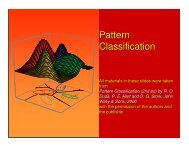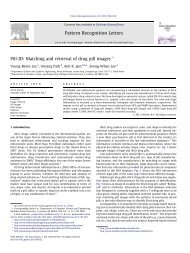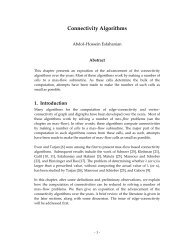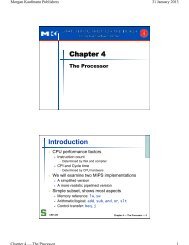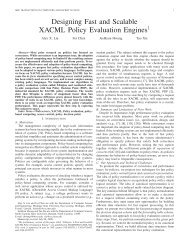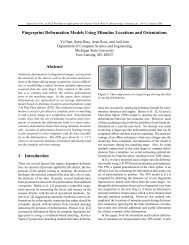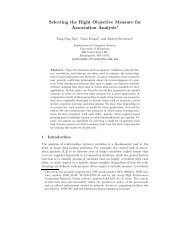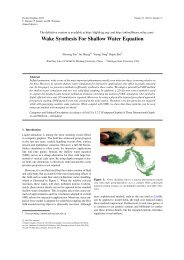Latent Fingerprint Matching using Descriptor-Based Hough Transform
Latent Fingerprint Matching using Descriptor-Based Hough Transform
Latent Fingerprint Matching using Descriptor-Based Hough Transform
Create successful ePaper yourself
Turn your PDF publications into a flip-book with our unique Google optimized e-Paper software.
computed as a vector correlation measure. A more detailed<br />
description of the cylinder generation and of the similarity<br />
between two cylinders can be found in [1]. This representation<br />
presents some advantages, such as: invariant to translation<br />
and rotation; robust against small skin distortion and<br />
missing or spurious minutiae; and of fixed length.<br />
2.2. <strong>Fingerprint</strong> Alignment<br />
<strong>Fingerprint</strong> alignment or registration consists of estimating<br />
the parameters (rotation, translation and scale) that align<br />
two fingerprints. There are a number of features that may<br />
be used to estimate alignment parameters between two fingerprints,<br />
including orientation field, ridges and minutiae.<br />
There are also a number of ways of aligning two fingerprints:<br />
Generalized <strong>Hough</strong> <strong>Transform</strong>, local descriptors, energy<br />
minimization, etc.<br />
In the latent fingerprint case, singularities are not always<br />
present, making it difficult to base the alignment of<br />
the fingerprint on singular points alone. To obtain manually<br />
marked orientation field is expensive, and to automatically<br />
extract orientation field from a latent image is a very<br />
challenging problem. Since manually marking minutiae is a<br />
common practice for latent matching, our approach to align<br />
two fingerprints is based on minutiae.<br />
Ratha et al. introduced an alignment method for minutiae<br />
matching that estimates rotation, scale, and translation<br />
parameters <strong>using</strong> a Generalized <strong>Hough</strong> <strong>Transform</strong> [14].<br />
Figure 3. Overview of the proposed approach.<br />
Given two sets of points (minutiae), a matching score is<br />
computed for each transformation in the discretized set of<br />
all allowed transformations. For each pair of minutiae, one<br />
minutia from each set, and for given scale and rotation parameters,<br />
unique translation parameters can be computed.<br />
Each parameter receives “a vote” proportional to the matching<br />
score for the corresponding transformation. The transformation<br />
that gives the maximum score is considered the<br />
best one. In our approach, the alignment is conducted in<br />
a very similar way, but the evidence for each parameter is<br />
accumulated based on the similarity between the local descriptors<br />
of the two involved minutiae, with the similarity<br />
and descriptor being the ones described in Section 2.1.<br />
Given two sets of minutiae, one from the latent and the<br />
other from the rolled print being compared, translation and<br />
rotation parameters can be obtained for each possible minutiae<br />
pair (one minutia from each set). Let {(





